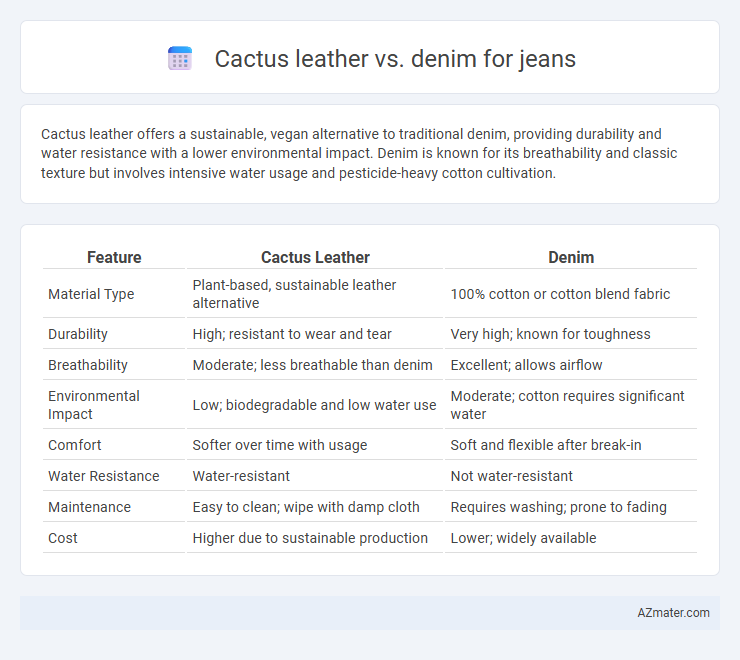Cactus leather offers a sustainable, vegan alternative to traditional denim, providing durability and water resistance with a lower environmental impact. Denim is known for its breathability and classic texture but involves intensive water usage and pesticide-heavy cotton cultivation.
Table of Comparison
| Feature | Cactus Leather | Denim |
|---|---|---|
| Material Type | Plant-based, sustainable leather alternative | 100% cotton or cotton blend fabric |
| Durability | High; resistant to wear and tear | Very high; known for toughness |
| Breathability | Moderate; less breathable than denim | Excellent; allows airflow |
| Environmental Impact | Low; biodegradable and low water use | Moderate; cotton requires significant water |
| Comfort | Softer over time with usage | Soft and flexible after break-in |
| Water Resistance | Water-resistant | Not water-resistant |
| Maintenance | Easy to clean; wipe with damp cloth | Requires washing; prone to fading |
| Cost | Higher due to sustainable production | Lower; widely available |
Introduction to Cactus Leather and Denim
Cactus leather, derived from the nopal cactus, is an eco-friendly and sustainable alternative to traditional denim, offering a cruelty-free and biodegradable material for jeans. Denim, made primarily from cotton, is renowned for its durability, comfort, and classic style but has a high environmental impact due to water-intensive cultivation and chemical processing. Comparing cactus leather and denim highlights their distinct origins, environmental footprints, and performance characteristics in the fashion industry.
Material Origins and Sustainability
Cactus leather is derived from the mature leaves of the nopal cactus, requiring minimal water and no pesticides, making it a highly sustainable alternative to conventional materials. Denim, traditionally made from cotton, demands significant water usage and often involves chemical-intensive processes, raising environmental concerns. By contrast, cactus leather offers biodegradable properties and a lower carbon footprint, positioning it as an eco-friendly option in sustainable fashion for jeans.
Environmental Impact Comparison
Cactus leather offers a significantly lower environmental footprint than denim, using up to 80% less water and producing fewer greenhouse gas emissions during cultivation and processing. Denim production typically requires large quantities of water, pesticides, and synthetic fertilizers, which contribute to soil degradation and water pollution. Cactus leather's sustainable cultivation and biodegradable properties make it a promising eco-friendly alternative for jeans manufacturing.
Durability and Longevity
Cactus leather offers superior durability compared to traditional denim, boasting enhanced resistance to wear, tears, and abrasion due to its robust plant-based fibers. While denim is praised for its sturdiness, it tends to fade and weaken after repeated washes, whereas cactus leather maintains structural integrity and vibrant appearance over time. The longevity of cactus leather jeans is further supported by their natural water resistance and flexibility, making them a sustainable, long-lasting alternative to conventional denim.
Comfort and Wearability
Cactus leather offers exceptional softness and flexibility, making it a comfortable alternative to traditional materials in jeans, with natural breathability that reduces heat buildup. Denim, known for its durability and structure, can feel stiff initially but softens significantly with wear and washing, offering long-term comfort. While cactus leather provides a lightweight and stretchable wear experience, denim excels in robustness and ease of movement after break-in periods.
Aesthetic Appeal and Style
Cactus leather offers a sleek, modern aesthetic with a smooth, supple texture that contrasts sharply with the rugged, casual look of traditional denim, making it ideal for fashion-forward, eco-conscious consumers. Denim jeans, characterized by their durable weave and classic indigo tones, evoke timeless style and versatility, seamlessly fitting into both casual and semi-formal wardrobes. The choice between cactus leather and denim jeans ultimately depends on whether one prioritizes avant-garde elegance or enduring heritage style.
Cost and Market Availability
Cactus leather, a sustainable alternative to traditional materials, typically carries a higher price point for jeans due to its eco-friendly production process and limited market availability. Denim remains more cost-effective and widely accessible, dominating the global apparel market with established supply chains and mass production. Consumers seeking affordable and readily available jeans often prefer denim, while cactus leather appeals to niche markets prioritizing sustainability despite its premium cost.
Care and Maintenance Requirements
Cactus leather requires minimal maintenance compared to denim, as it is water-resistant and can be easily cleaned with a damp cloth, avoiding machine washing or harsh detergents. Denim needs regular washing to prevent odor and maintain softness, but frequent laundering can cause fading and fabric wear over time. Both materials benefit from air drying, but cactus leather should be kept away from direct heat sources to preserve its texture and durability.
Ethical Considerations
Cactus leather offers a sustainable and cruelty-free alternative to traditional denim, reducing environmental impact by using biodegradable and water-efficient materials. Denim production often involves heavy water consumption, chemical use, and intensive pesticide application, raising ethical concerns regarding resource depletion and pollution. Choosing cactus leather jeans supports a shift towards more ethical fashion practices, emphasizing vegan materials and lower ecological footprints.
Future Trends in Sustainable Jeans
Cactus leather is emerging as a sustainable alternative in the fashion industry due to its biodegradability and low water usage compared to traditional denim production, which demands significant water and chemical inputs. Innovations in cactus leather technology emphasize durability and breathability, making it a viable material for future jeans that align with eco-conscious consumer demands. As sustainability trends drive industry shifts, combining cactus leather with recycled denim or biodegradable fibers is expected to enhance circularity and reduce environmental impact in future jeans collections.

Infographic: Cactus leather vs Denim for Jeans
 azmater.com
azmater.com